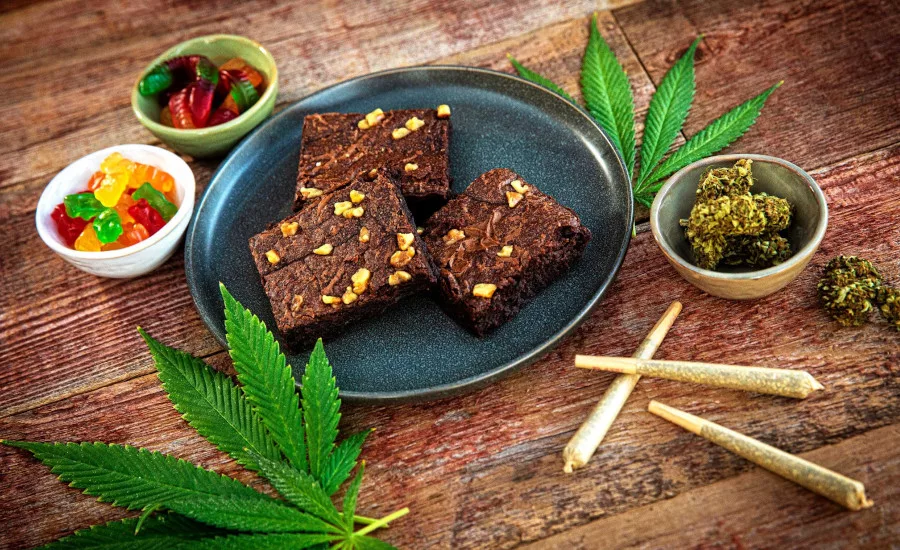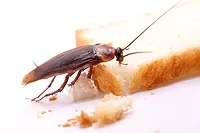What the Food Safety Industry Needs to Know about Cannabis and Hemp Testing
Complex chemistry and consumer concerns make safe edibles a must

While the food safety testing industry has evolved over several decades, the testing of regulated hemp and Cannabis products has existed for only a handful of years. Despite being legal in 36 states and four U.S. territories, marijuana is not legal at the federal level, which creates dramatic differences in regulatory requirements.
“Marijuana” is defined as any Cannabis plant with a concentration of delta-9 tetrahydrocannabinol (THC) of greater than 0.3 percent. Delta-9 THC is one of the psychoactive cannabinoids predominantly found in Cannabis and is primarily associated with the euphoric effects of the plant. Marijuana is highly regulated by states, with much more defined testing standards around specific analytes and action limits. On the other hand, the requirements for testing hemp flower, oils, and edibles are limited, and in some states, the only required testing is to confirm that the flower in the fields contains less than 0.3 percent delta-9 THC.
Regardless, if marijuana is being used as an ingredient in foods, it needs to be safe to consume. Marijuana ingestion is why food safety professionals must partner with facilities that are experts in managing testing that includes Cannabis edibles.
A Brief Background on Marijuana and Hemp Testing
Marijuana testing has been a core requirement for consumer products as more state-level markets adopt medical marijuana and, eventually, adult-use Cannabis programs. Likewise, in an adult-use market, regulatory agencies need to assure consumers that the products are safer than those on the black market. Black-market products tested throughout the U.S. consistently contain dangerous levels of many different pesticides, heavy metals, and microbials. Some states have also seen failing product diverted from the legal market to the black market illegally rather than being destroyed by the producer.
New testing labs, such as Method Testing Labs (MTL) in Tampa, Florida, address the challenges of the complex and fast-growing Cannabis testing industry. Such labs tackle the challenges and inconsistencies created by existing laboratories in the market, along with the important role of safety testing in the marijuana and hemp supply chains.
MTL specializes in Cannabis and hemp testing to ensure the compliance and safety of products for the hemp market nationwide and for the medical marijuana/edibles market in Florida.
Looking for quick answers on food safety topics?
Try Ask FSM, our new smart AI search tool.
Ask FSM →
The main types of products tested include flower, oil, and edibles. “Edibles” refers to any products that are not flower, Cannabis oil, or concentrates and can include everything from seltzer to gelato but typically include cookies, chocolate bars, and gummy candies. Edibles are the most challenging products to test due to their wide variety of different forms and matrices. “Flower” is the literal flower from the Cannabis plant and is also referred to as a bud. It is the product that is most associated with Cannabis and is the most-consumed form of the plant.
Cannabis oils and concentrates are produced by concentrating the oils from the Cannabis flower. Many different extraction techniques are used for oils and concentrates, including those involving ethanol, CO2, hydrocarbons, pressure/heat, and ice.
How Cannabis and Hemp Testing is Evolving
Lab scientists perform both compliance and R&D testing for customers. Testing services offered include cannabinoid potency, agricultural agents, residual solvents, terpenes, heavy metals, various microbials, total yeast and mold, water activity, and moisture content. All of these tests combined are known as a “full panel” test.
For hemp edible products, it is recommended to test the potency and presence of pesticides, heavy metals, residual solvents, microbials, water activity, and total yeast and mold.
“We are always researching and thinking about new ways to expand and improve our analytical and microbiological testing methods,” says Rob Radke, MTL president. “We are currently working on expanding the number of cannabinoids that we profile as new cannabinoids gain importance and market share. For our hemp customers, we are also in the process of expanding the number of residual solvents and pesticides that we analyze because of the differences in analytes that exist between each state.”
The company is also looking at dramatically expanding the number of terpenes analyzed to over 100. Research continues to show that terpenes play a crucial role in the Cannabis plant and its effects on people. Allowing its customers to analyze many terpenes and generate insights into the plants that they cultivate is the future of Cannabis testing.
Cannabis Testing Models and FDA Testing Requirements
In addition to analytical testing, product stability testing is an important component. Customers work directly with lab scientific teams to design a study to suit their specific needs. Some customers prefer room-temperature studies, while others seek a more accelerated study. According to study design, the laboratory will pull samples at different intervals to check the key characteristics of the product, which can change or develop with time. State regulators for Cannabis and hemp markets are beginning to require expiration dates, and large Cannabis processors are putting in the work to better understand their products and shelf life.
These tests are performed according to ISO 17025 standards for testing laboratories. In addition, laboratories should adhere to strict quality standards practiced in the food and pharmaceutical industries in anticipation of future regulation by the U.S. Food and Drug Administration.
“Our labs are always audit ready, and the quality system we have implemented incorporates best-in-class aspects from the food and drug industries,” says Radke. “We have quality checks built into our process and we know our results are reliable and defensible. In addition, several teammates, including myself, are SQF3 and HACCP certified and have a keen understanding of our customers and the challenges of manufacturing.”
What Does This Mean for the Testing and Safety of Edibles?
As mentioned, the diversity of matrices makes edibles the most challenging products to analyze. Additionally, they are generally difficult to produce compared with a flower, which is only trimmed. Edibles require precise formulations that are achieved through several rounds of potency testing on top of the experience required to manufacture them. Some edibles, such as beverages, have inherent challenges with can liners that are not broadly understood. Another issue within the realm of edibles testing is chocolate—one of the most popular edible products in the U.S.
“Chocolate is one of the most challenging edibles that we see on a consistent basis,” explains Roy Sorenson, MTL laboratory director. “The difficulty in analyzing chocolate is due to the complex nature of the chocolate matrix, which includes fats, sugars, and cocoa, which impact the cannabinoids in different ways. Cannabinoids can bind with the fats, which causes poor extractions from the sample, and the sugars and cocoa matrix tend to interfere with the chromatography. These interactions and inferences have led to changes in our sample prep so we can be sure that our extraction prior to analysis was complete.” He adds, “We are always reading the latest research and speaking with the instrument manufacturers to follow developments around edibles analysis. Given how early we still are in the Cannabis industry, I expect to see a significant amount of method development continue into the future.”
Another challenging aspect of testing these products is requirements around cannabinoid homogeneity. A common issue when the first medical marijuana markets were developing was inconsistencies between and within batches of edible products. For example, between batches, it was common to have a 100-mg-THC chocolate bar test as 110 mg or 60 mg, depending on the batch. This level of inconsistency was due to little knowledge of the production process and unreliable testing, which resulted in unreliable formulations.
Another issue was inconsistencies within the batch. An example would be a 100-mg-THC chocolate bar that could be broken down into 10-mg-THC pieces. It was common to find bars that would have some pieces with 0 mg of THC and others with 25 mg of THC, wildly inconsistent dosages.
“In the state of Florida, we are required to test edibles for homogeneity. This requires us to sample several different bars and pieces from those bars according to standards set by the Department of Health. For a typical order, we can test up to 100 individual pieces for cannabinoid potency. Then, these values are compared to ensure that the level of variability is within the guidelines set by the State,” says Sorenson.
Blurred Lines Means Greater Need for Accurate Testing
Cannabis and hemp testing is an exciting new industry that has close parallels to the food safety industry. Unlike the food industry, though, Cannabis and hemp products blur the lines between pharmaceutical, food, and cosmetic products. This creates unique challenges and requires specific experience within the Cannabis industry to understand best-in-class methodology and techniques. Various matrix challenges combined with strict analytical requirements have resulted in detailed and robust methods that accurately identify and quantify target analytes with high repeatability.
Analytical testing plays a crucial role in the Cannabis and hemp industries. The guidelines established by regulators have been critical to helping consumers feel safe about the products they are purchasing. Consumers understand that legal-market products are safe to consume, which is a key differentiator between the legal and the black markets.
Most importantly, Cannabis and hemp product safety testing helps keep unsafe products from reaching consumers. This screening helps prevent product-borne illness, which is especially important for medical marijuana patients with serious illnesses.
Much like in the food safety industry, hemp and Cannabis testing continues to expand. For example, Colorado recently added vapor testing requirements, which test the actual contents of the vapor cloud generated by the concentrate. This type of testing helps determine the safety of both the concentrate and the hardware. States are also looking to expand pesticide testing to over 300 analytes, as with some categories of food.
In an industry that moves so rapidly, it is essential to work with industry leaders who understand customer requirements and the importance of high-quality, fast, and accurate safety testing.
Tony Bennett is the Laboratory Quality Manager at Method Testing Labs. He directs the company’s quality and compliance operations. He has more than 25 years of experience in quality assurance in the pharmaceutical, herbicide, pesticide, metallurgy, food, and beverage industries.








